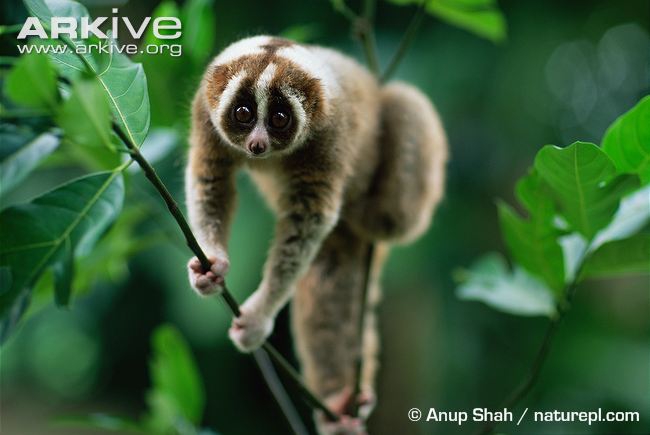| Citation |
Nekaris, A. & Streicher, U. 2008. Nycticebus coucang. The IUCN Red List of Threatened Species 2008: e.T39759A10263403. http://dx.doi.org/10.2305/IUCN.UK.2008.RLTS.T39759A10263403.en. Downloaded on 06 August 2019. |
Description |
RANGE DESCRIPTION
This species occurs in Indonesia (Sumatra, Batam and Galang in the Riau Archipelago, and Pulau Tebingtinggi and Bunguran in the North Natuna Islands), Malaysia (on the Peninsula and the island of Pulau Tioman), southern peninsular Thailand (from the Isthmus of Kra southward), and Singapore (Groves 2001; M. Shekelle pers. comm.)
DESCRIPTION
Surveys in Sumatra have found this species to occur at very low densities. Its presence is patchy through Peninsular Malaysia. Several short-term studies indicated that it usually occurs at low densities: Pasoh Forestry Research Centre, Peninsular Malaysia (0.01-0.02 animals/km); Petalang Jaya, Malaysia (0.40 animals/km); Genting Sempah, Malaysia (3 captures after 30,000 trap nights) (Barret 1981; Rudd and Stevens 1992; Nekaris et al. in press). It was described as uncommon in Panang Island, where one was shot after 11 nights (Liat et al 1971). But at sites where long-term studies were chosen found forests where they occur at particularly high densities (Sungai Tekam Forestry Concession, Malaysia, 0.3-0.8 animals/km in logged primary forest, 0.5-1.2 animals/km in unlogged primary forest; Manjung District, Perak, Malaysia, 1.6-4.0 animals/km in unlogged primary forest and 0.4-1.0 animals/km in logged swamp forest and secondary savanna). In general, though, slow lorises of all taxa appear to occur at very low densities (Nekaris et al. in press).
HABITAT AND ECOLOGY
The species occurs in primary and secondary lowland forest, gardens, and plantations (Timm and Birney 1992). It is seen more often in edge habitat of forest, possibly because the edge has more supports that may increase foraging efficiency (Johns 1986), but this also may be due to sampling bias, as they are more easily seen on forest edges (Nekaris et al. in press). It is frugivorous, but will also eat insects, leaves, and bird eggs (Johns 1986). One long-term study has shown that they consume mainly nectar gum and sap, with fruit and arthropods forming small proportion of diet. Nectar from the flowers of the burtram palm (Eugeissona tristus) seems to be a key resource (Wiens and Zitzmann 2003).
THREATS
The species is collected for use as pets, and the animals are sold throughout Southeast Asia (Nekaris and Bearder 2007; Nekaris and Nijman 2007). The teeth are often pulled, resulting in infection and/or death. If animals survive, lack of teeth makes reintroduction impossible. Well-meaning rescue centres haphazardly reintroduce lorises into local forests without knowledge of their taxonomy or social needs. Sumatran populations are particularly impacted by the pet trade. There is little information available on other threats to this species. It is relatively adaptable to anthropogenic habitats, and so it might less affected by forest loss than some other primate species. Nevertheless, forest loss has been so severe in the region that it is likely to have had some negative impacts. Animals are shot as crop pests and for other reasons (Bennett et al. 1994).
CONSERVATION ACTIONS
The species occurs in several protected areas throughout its range. Studies on Sumatra are urgently needed to confirm conservation status. The species is protected by law in Malaysia, Thailand and Indonesia, and has been recently transfer from Appendix II to Appendix I of CITES (Nekaris and Nijman 2007). |


